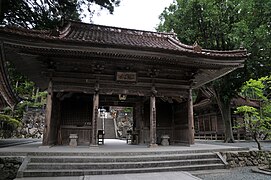Meiseki-ji
The Meiseki-ji ( Japanese 明石 寺 ) with the Go Genkōzan (源 光山) and Enshuin (円 手 院) is a temple of the Jimon direction (寺 門派) of Tendai Buddhism in the city of Seiyo ( Ehime Prefecture ). In the traditional count, it is the 43rd temple on the Shikoku pilgrimage route .
history
The district of Uwa is steeped in history with its old burial mounds. Since St. Kannon is said to have appeared here as a young woman, the area is also related to faith. In the first half of the 6th century, at the request of the emperor Kimmei , in office from 532 to 571, priest Enshuin (円 手 院 正 澄) is said to have built a complete temple complex (七 堂 伽藍, shichdō garan). In the year 734 priest Jugen (寿 元), coming from Kumano, visited the temple, carried out repairs and added 12 Klausen to the complex.
In 822, Priest Kūkai visited the temple. When he saw the neglected temple grounds, he turned to Emperor Saga , who instructed him to restore the temple and its buildings. On the occasion, the temple received a valuable copy of the Hokke Sutra (法 華 経). At the beginning of the Kamakura period , the temple fell into disrepair. Now support came from Minamoto no Yoritomo (源 頼 朝), which led to a renaming: Genkōzan (現 光山) became the new Genkōzan (源 光山).
The temple continued to flourish , becoming a Saionji prayer temple in the Muromachi period . The princes of Uwajima, a branch of the Date clan , also chose it as their prayer stamp. It is reported that about 70 sub-temples belonged to the Meiseki-ji.
The attachment
If you come from the south, you enter the temple through the temple gate, which here is designed as a mighty Niō gate (仁王 門, Niō-mon; 1), as a gate that offers space for the two temple guards to the right and left of the passage . After a few steps you reach the main hall (本 堂, Hondō; 2) with its "Chinese canopy" (唐 破 風, Kara hafu) , which dates from the Meiji period , and to the right of it is the hall dedicated to the temple founder, the Daishidō (大師 堂; 3 ). Opposite it is the housing for the temple bell (鐘楼, Shōrō; 4), which, unlike usual, is rung, i.e. not struck with a bar. On the area below is the pavilion for the Emmei-Jizōdō (延命 地 蔵 堂; 5).
If you come from the west, you pass the spring, which is named after the posthumous name of Kūkais, "Kōbō Daishi", "Kōbō source" (弘法 井 戸, Kōbō ido; 8). If you turn left, you have the hand washbasin on the right (手 水 舎, Temizuya; 6). On the right edge of the temple is the "Glücks-Kannon" (し あ わ せ 漢 音, Shiawasa Kannon; 7). In the south is the monastery quarter (本 坊, Honbō; A).
In connection with the temple is the Kumano Shrine (熊 野 神社, Kumano Jinja; 9).
photos
literature
- Ehime-ken kotogakko chireki komin bukai rekishi bukai (Ed.): Meiseki-ji . In: Ehime-ken no rekishi sampo. Yamakawa Shuppan, 2008. ISBN 978-4-634-24638-6 . Page 187.
- Oguri, Doei: Kukai. Shikoku hachijuhachi kosho no arukikata. Chukei no Bunko, 2011, ISBN 978-4-8061-4067-2 .
Web links
Coordinates: 33 ° 22 '9.2 " N , 132 ° 31' 8.3" E
← Previous Temple: Butsumoku-ji | Meiseki-ji | Next temple: Taihō-ji →







